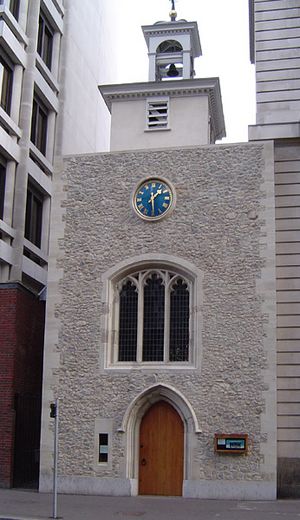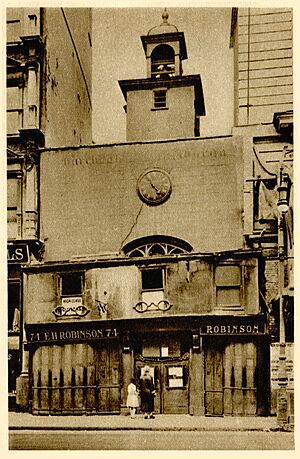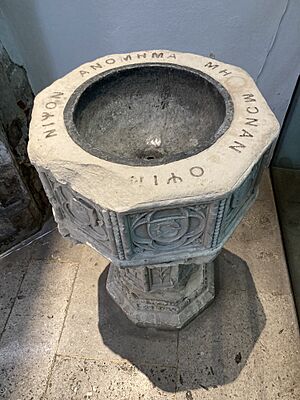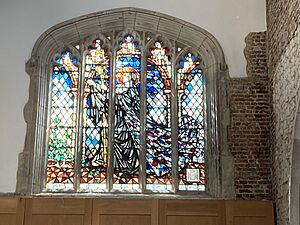St Ethelburga's Bishopsgate facts for kids
Quick facts for kids St Ethelburga's Bishopsgate |
|
|---|---|

Current church building
|
|
| Location | London, EC2 |
| Country | United Kingdom |
| Denomination | Church of England |
| History | |
| Founded | c.1250 |
| Architecture | |
| Heritage designation | Grade I listed building |
| Administration | |
| Diocese | London |
St Ethelburga-the-Virgin within Bishopsgate is a Church of England church in the City of London. It is located on Bishopsgate street, close to Liverpool Street station.
This church is one of the few old medieval churches left in London. Its exact start date is not known. However, it was first mentioned in records in 1250. At that time, it was called the church of St Adelburga the Virgin.
The church was rebuilt around 1411. Some parts of this older building still remain today. You can see them especially in the south side of the church.
Sadly, the church was badly damaged by an IRA bomb in 1993. After a lot of rebuilding and fixing, it opened again. Now, it serves as a special place called the Centre for Reconciliation and Peace.
Contents
Exploring the History of St Ethelburga's
This church is a rare survivor among the old churches in London. Most of them were destroyed during the Great Fire of London in 1666. St Ethelburga's is named after St Ethelburga. She was a religious leader (an abbess) in the 7th century. She was also the sister of Saint Erkenwald, who was a Bishop of London.
The church was first recorded in 1250. It was known as the church of St Adelburga-the-Virgin. The "the-Virgin" part was removed for a while but later put back.
Changes Over the Centuries
The church was rebuilt in the 15th century, possibly around 1411. A small square tower for bells was added in 1775. A weathervane was put on top in 1671. To earn money, the church had a wooden porch built in the 16th century. This porch held two shops right outside the church.
In 1932, big changes happened when Bishopsgate street was made wider. The shops were taken down, and the porch was removed. This was the first time in hundreds of years that the front of the church could be seen clearly.
Surviving Bomb Damage
During the Blitz in the Second World War, the church had some minor bomb damage. It was fixed up in 1953. But in 1993, a huge IRA bomb exploded very close to the church. The explosion badly damaged Bishopsgate and destroyed half of St Ethelburga's.
Some people wanted to knock down the church completely. But many people protested and wanted it saved. So, it was rebuilt to look like its original plan. The inside was changed quite a bit, but the church stood strong again.
What St Ethelburga's Looks Like Inside
The church has a small inside area. It includes a main space (nave) and a side area (aisle). These are separated by an archway. Most of the original decorations and furniture were destroyed by the 1993 bombing. These items were from the early 20th century. They were designed by an artist named Ninian Comper.
The Unique Font
One special thing that survived is the church's font. This is a basin used for baptisms. It's from the 19th century and has a very interesting inscription. It's one of the longest known palindromes. A palindrome is a word or phrase that reads the same forwards and backwards. This one is in Greek: ΝΙΨΟΝ ΑΝΟΜΗΜΑΤΑ ΜΗ ΜΟΝΑΝ ΟΨΙΝ. It means "Cleanse your wrongdoings, not only your face."
The church was officially named a Grade I listed building on January 4, 1950. This means it's a very important historic building. Even after being rebuilt, it kept this special status.
St Ethelburga's Centre for Reconciliation and Peace
St Ethelburga's Centre for Reconciliation and Peace is a non-profit charity. Its main goal is to help people from different backgrounds, cultures, and religions connect. They work to build understanding and peace.
What the Centre Does
The centre does many things, including:
- Helping faith leaders: They have a program where leaders from different religions learn to work together. This helps them respond better to disagreements.
- Community peace: They help build peace among groups of people, like the North and South Sudanese communities in London.
- Sharing stories: They encourage people to share their personal stories. This helps people understand and feel for others with different experiences.
- Exploring meaning: They look at how to bring a deeper sense of purpose into areas like the environment, leadership, and business.
- Education: They offer a Master's degree in reconciliation at Winchester University.
- Cultural exchange: They mentor young adults to become leaders in social action.
The centre also offers a three-day course on how to handle conflicts. This course is for anyone dealing with problems at work or in their personal life.
Special Events and Partnerships
The centre works with a company called Seasoned Events. This company helps with renting out the building for events.
Every year, the Centre organizes a 10-kilometer walk called 'The Ethelburga Walk'. This walk connects two historic places linked to St Ethelburga of Barking: Barking Abbey and St Ethelburga's Centre.
St Ethelburga's is also a partner in the community of the Cross of Nails. This is a worldwide network of churches and organizations working for peace and reconciliation.
Notable People Connected to St Ethelburga's
Many interesting people have been associated with St Ethelburga's church over the years.
- Blessed John Larke (Rector from 1504–1544): He was a church leader who died for his beliefs. He refused to accept the King's power over spiritual matters.
- Henry Hudson (Explorer): Before he set off to find the Northwest Passage in 1607, this famous explorer and his crew took communion at the church.
- Charles Viner (1678-1756): A legal writer who got married in the church in 1699.
- John Medows Rodwell (Rector from 1843–1900): He created the first reliable English translation of the Qur'an in 1861.
- W. F. Geikie-Cobb (Rector from 1900–1941): He became well-known for performing marriages for many people who had been divorced.
- Singers Webster Booth and Anne Ziegler (born Irené Frances Eastwood): Their marriage was blessed by W. F. Geikie-Cobb in a special ceremony for divorced persons on November 5, 1938.




